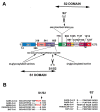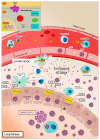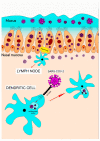Dendritic Cells and SARS-CoV-2 Infection: Still an Unclarified Connection
- PMID: 32911691
- PMCID: PMC7564940
- DOI: 10.3390/cells9092046
Dendritic Cells and SARS-CoV-2 Infection: Still an Unclarified Connection
Abstract
The ongoing pandemic due to Severe Acute Respiratory Syndrome Coronavirus 2 (SARS-CoV-2) has so far infected about 2.42 × 107 (as at 27 August 2020) subjects with more than 820,000 deaths. It is the third zoonotic coronavirus-dependent outbreak in the last twenty years and represents a major infective threat for public health worldwide. A main aspect of the infection, in analogy to other viral infections, is the so-called "cytokine storm", an inappropriate molecular response to virus spread which plays major roles in tissue and organ damage. Immunological therapies, including vaccines and humanized monoclonal antibodies, have been proposed as major strategies for prevention and treatment of the disease. Accordingly, a detailed mechanistic knowledge of the molecular events with which the virus infects cells and induces an immunological response appears necessary. In this review, we will report details of the initial process of SARS-CoV-2 cellular entry with major emphasis on the maturation of the spike protein. Then, a particular focus will be devoted to describe the possible mechanisms by which dendritic cells, a major cellular component of innate and adaptive immune responses, may play a role in the spread of the virus in the human body and in the clinical evolution of the disease.
Keywords: Covid-19; DC-SIGN; SARS-CoV-2; dendritic cells; spike protein.
Conflict of interest statement
The authors declare no conflict of interest.
Figures



References
Publication types
MeSH terms
Grants and funding
LinkOut - more resources
Full Text Sources
Miscellaneous

